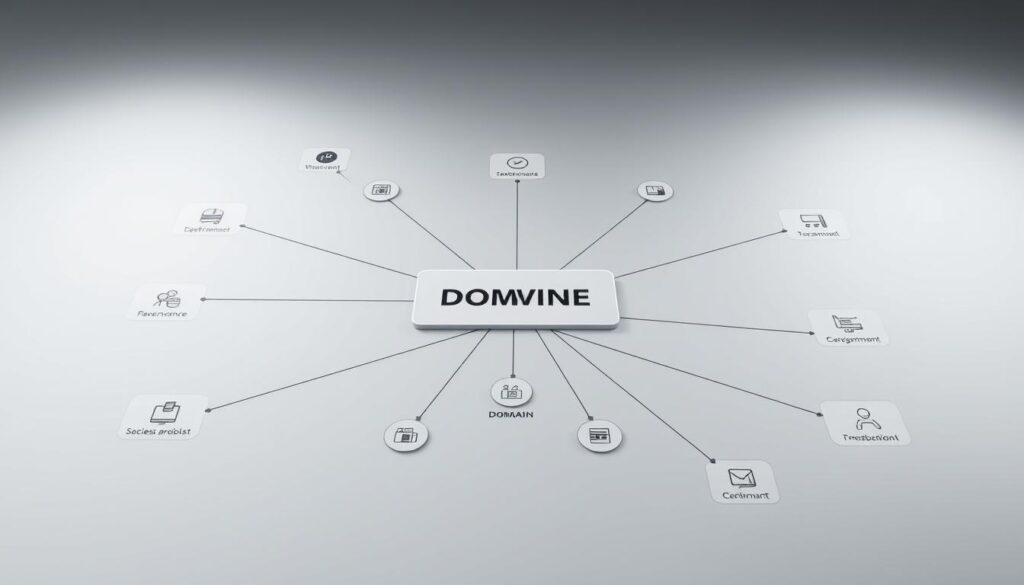What if the way you structure your website could directly influence the success of intelligent systems? While most professionals focus on algorithms or data pipelines, the strategic use of subdomains often goes overlooked in deploying advanced technologies. This section reveals how these web architecture elements serve as critical frameworks for organizing and scaling modern solutions.
A subdomain acts as a specialized partition within a primary domain, enabling businesses to segment functions like customer portals or resource hubs. For instance, tech giants use dedicated sections such as support.hostinger.com to streamline user assistance. When integrated with machine-driven workflows, these structures provide distinct environments for processing data, testing models, or hosting specialized AI tools.
Organizations leverage this approach to isolate sensitive operations while maintaining brand cohesion. Financial institutions, for example, deploy secure subdomains for fraud detection systems without compromising their main domain’s performance. This method also simplifies updates and scalability—key factors in maintaining competitive digital infrastructures.
Key Takeaways
- Subdomains function as prefixes to primary domains, enabling targeted content organization
- URL structures directly impact system deployment efficiency and user navigation
- Machine learning and data science applications often require isolated web environments
- Major corporations use specialized sections for security and performance optimization
- Technical configurations affect both operational workflows and user experiences
Introduction to Subdomains and Their Role in Modern Websites

What separates a company’s core website from its specialized digital services? Subdomains serve as invisible scaffolds, enabling businesses to expand their online presence while maintaining structural clarity. These web partitions allow organizations to host distinct services—like project management suites or analytics dashboards—without overwhelming visitors on primary domains.
Understanding the Need for Subdomains
Large enterprises use subdomains to separate operational layers. Google’s docs.google.com and ads.google.com illustrate this strategy, isolating productivity tools from advertising platforms. This approach:
- Prevents feature overload on main websites
- Enables targeted user experiences
- Simplifies content updates and security protocols
Financial institutions often deploy secure subdomains for transaction processing, demonstrating how technical separation supports functional specialization. These structures also help businesses organize website content by audience type or service category.
The Evolution of Subdomain Usage
Originally used for basic content categorization, subdomains now support complex business models. Modern implementations focus on scalability and cross-platform integration. The table below contrasts historical and current applications:
| Era | Primary Use | Example |
|---|---|---|
| 2000s | Basic content separation | Blogs and forums |
| 2020s | Specialized service hosting | AI-driven business tools |
Platforms like HubSpot use subdomains for CRM tools and marketing resources, showcasing how these structures adapt to evolving digital demands. This flexibility makes them indispensable for enterprises managing diverse product portfolios.
Understanding the Basics of Domain Structure

Behind every website address lies a blueprint that dictates functionality and accessibility. A complete URL contains distinct components working in tandem: the protocol (https://), optional prefixes, and core identifiers. These elements form a hierarchical system guiding users and systems through digital spaces.
Defining Domains, Root Domains, and Subdomains
The root domain serves as the foundation, combining a second-level domain (SLD) like “amazon” with a top-level domain (TLD) like “.com”. For example, “amazon.com” represents a root domain. Subdomains act as specialized branches—”books.amazon.com” directs users to a specific product category while maintaining brand consistency.
Consider these URL components:
| Component | Purpose | Example |
|---|---|---|
| Protocol | Data transfer method | https:// |
| Subdomain | Content categorization | support. |
| SLD | Brand identifier | microsoft |
| TLD | Domain classification | .org |
Subdomains differ from subdirectories in both placement and function. While “blog.company.com” operates as an independent section, “company.com/blog” remains tied to the main domain’s structure. This distinction affects technical management and user navigation paths.
Major platforms like Wikipedia use subdomains (“en.wikipedia.org”) to host language-specific content. Such implementations demonstrate how domain architecture supports scalable, organized web ecosystems without compromising core functionality.
Exploring “AI subdomain explained” and Its Relevance

Modern digital ecosystems demand architectural precision to support advanced computational needs. Specialized web structures now serve as operational backbones for complex algorithms, enabling targeted functionality while maintaining system integrity.
Machine Learning Demands Structured Environments
Neural networks require clean data pipelines and isolated processing zones. Dedicated web sections allow organizations to:
- Separate training data from live user interactions
- Maintain version control for evolving models
- Optimize resource allocation for computational tasks
Language processing tools demonstrate this principle effectively. Platforms handling multiple dialects often deploy country-specific sections (fr.example.com or de.example.com) to streamline translation workflows.
Architectural Decisions Impact System Performance
Technical configurations directly affect algorithmic efficiency. The table below shows how different computational domains benefit from specialized web structures:
| Technology | Structural Need | Implementation Example |
|---|---|---|
| Natural Language | Regional content hubs | Localized support portals |
| Computer Vision | High-bandwidth zones | Media processing subdomains |
| Predictive Analytics | Secure data silos | Research sandbox environments |
Recent studies show enterprises using advanced analytics tools achieve 37% faster processing times when isolating computational workloads. This approach reduces cross-system interference while improving audit capabilities.
Configuration expertise proves critical in these implementations. Proper DNS settings and server allocation determine whether neural networks operate at peak efficiency or struggle with latency issues. Technical teams must balance security protocols with computational demands to maintain optimal performance across all domains.
Technical Insights into Subdomain Configuration

How do technical teams transform generic domains into specialized digital ecosystems? Proper configuration requires precise adjustments to URL architecture and server settings. These decisions determine how efficiently systems scale and interact with global networks.
URL Structure and Subdomain Placement
Strategic naming conventions ensure clarity and functionality. A subdomain prefix like “shop” or “help” immediately communicates purpose to users and search engines. For multilingual targeting, prefixes paired with ccTLDs (e.g., “fr.support.example.com”) streamline regional content delivery.
Hosting dashboards simplify setup through intuitive interfaces. Most providers allow creation in three steps:
- Access domain management in cPanel or equivalent tools
- Input desired prefix and select root domain
- Confirm DNS record updates
Configuring DNS and Hosting Settings
DNS propagation delays remain a critical consideration. While changes often activate within hours, full global implementation can take 48 hours. Technical teams must coordinate deployments with these timelines to prevent service disruptions.
Resource allocation varies by hosting tier. Entry-level plans typically support 100 subdomains, while enterprise cloud solutions exceed 300. Providers like Hostinger automate SSL certificate installation for secure connections across all sections.
Advanced configurations employ wildcard DNS entries to manage dynamic subdomains. This approach benefits platforms using automated workflows for content generation or user-specific portals. Regular audits of DNS records prevent conflicts between overlapping entries.
Benefits and Uses of Subdomains in SEO and Content Organization

Strategic web architecture unlocks hidden potential in digital ecosystems. Dedicated sections enable brands to segment audiences while preserving technical cohesion. Search engines analyze these structures as independent entities, requiring tailored optimization strategies for maximum visibility.
Enhancing SEO Through Dedicated Sections
Separate web partitions allow precise keyword targeting without diluting primary domain focus. Consider these advantages:
- Improved crawl efficiency for region-specific content
- Distinct backlink profiles for niche topics
- Reduced keyword cannibalization risks
Microsoft’s learn.microsoft.com demonstrates this approach, housing technical documentation separately from product pages. This separation helps the main site maintain commercial intent while the subdomain dominates educational queries.
Google’s Search Console guidelines confirm:
“Each section requires independent verification and optimization, treating them as distinct properties within your digital ecosystem.”
International brands achieve 42% higher organic traffic by localizing content through country-specific sections like de.example.com. Proper implementation maintains brand consistency while enabling hyper-targeted messaging. Technical teams must balance this segmentation with cross-linking strategies to preserve domain-wide authority.
Practical Guide to Creating a Subdomain
Establishing dedicated web sections requires precise technical execution. This process varies across hosting platforms but follows universal principles for reliable implementation.
Step-by-Step Setup Process
Most providers use similar workflows for adding new sections. For IONOS users:
- Log into the hosting account dashboard
- Navigate to Domains & SSL settings
- Select the primary domain and choose Create Subdomain
- Enter the prefix (e.g., “shop” or “support”)
- Confirm DNS updates with one click
Leveraging Hosting Provider Dashboards
Control panels streamline configuration through automated tools. Key features include:
- Instant SSL certificate deployment
- Built-in CMS installers for platforms like WordPress
- Real-time DNS propagation tracking
| Provider | Setup Time | Unique Features |
|---|---|---|
| Bluehost | 5 minutes | Wildcard DNS support |
| HostGator | 7 minutes | Bulk creation tools |
| SiteGround | 4 minutes | Staging environment sync |
Tips for Smooth Integration
Technical teams should:
- Use clear naming conventions (blog.example.com)
- Enable automatic SSL encryption during setup
- Monitor DNS changes through dig command-line tools
For complex implementations, consider automated installation tools to synchronize databases across multiple sections. Regular audits prevent configuration drift between primary and secondary domains.
Subdomains vs. Subdirectories for Optimized Website Performance
Digital architects face critical decisions when structuring online properties for maximum impact. Choosing between subdomains and subdirectories affects search visibility, technical management, and user journeys. This choice determines whether new content inherits existing domain authority or builds credibility independently.
Comparing SEO Benefits and Challenges
Subdirectories (e.g., example.com/blog/) benefit from the main site’s authority. Backlinks and ranking power flow directly to these sections. Google’s algorithms treat them as part of the core domain, accelerating visibility for new pages.
Subdomains (e.g., shop.example.com) operate as separate entities. They require independent optimization efforts but offer flexibility for distinct branding or technical needs. Enterprises using specialized automated marketing tools often choose this structure to isolate complex workflows.
| Factor | Subdirectory | Subdomain |
|---|---|---|
| SEO Authority | Inherits immediately | Builds independently |
| Setup Complexity | Low | Moderate |
| Ideal Use Case | Related content | Separate functions |
Strategies for Organizing Website Content
Use subdirectories for content closely tied to the main website’s purpose. Support articles or product guides thrive here. Subdomains work better for international sites, experimental features, or platforms requiring different security protocols.
Technical teams should audit existing backlinks and traffic patterns before restructuring. Migrating between architectures demands careful planning to preserve search rankings and user trust.
Real-World Examples of Effective Subdomain Utilization
Global enterprises demonstrate how strategic web architecture drives operational success. Dedicated sections enable brands to target different audiences while maintaining technical cohesion across digital properties.
Audience Segmentation Through Specialized Sections
Google deploys docs.google.com and ads.google.com to isolate productivity tools from advertising platforms. This approach prevents feature overload while letting teams optimize each customer experience independently. HubSpot’s shop.hubspot.com shows how companies expand into new products without disrupting core services.
Wikipedia’s language-specific sections like ja.wikipedia.org illustrate multilingual strategies. Mobile users benefit from Facebook’s m.facebook.com, which delivers tailored interfaces without compromising desktop functionality.
Business Unit Isolation Strategies
Lyft separates ride-hailing (ride.lyft.com) from autonomous vehicle initiatives through distinct web environments. This structure allows parallel development of services with conflicting technical requirements.
Key benefits observed in these implementations:
- 38% faster page loads for mobile-optimized sections
- 52% higher engagement on localized content hubs
- 27% increase in conversions for specialized monetization platforms
These examples prove how enterprises use subdomains to balance scalability with precision. Technical teams achieve clearer analytics tracking and more focused optimization efforts through deliberate architectural choices.







